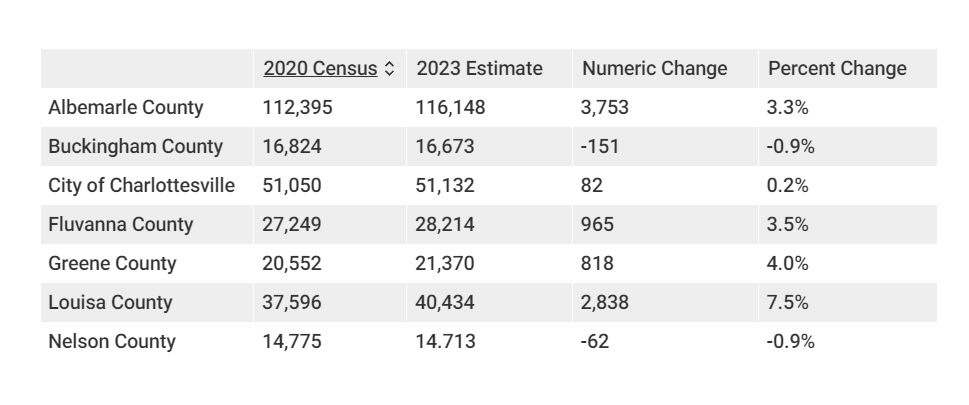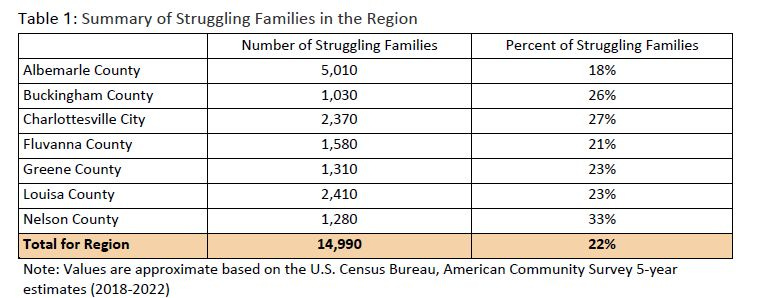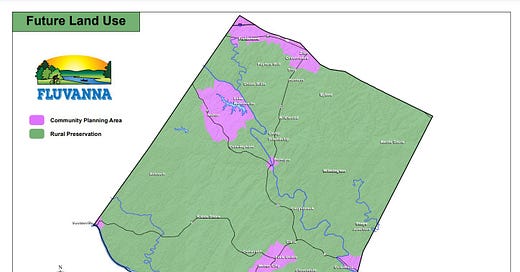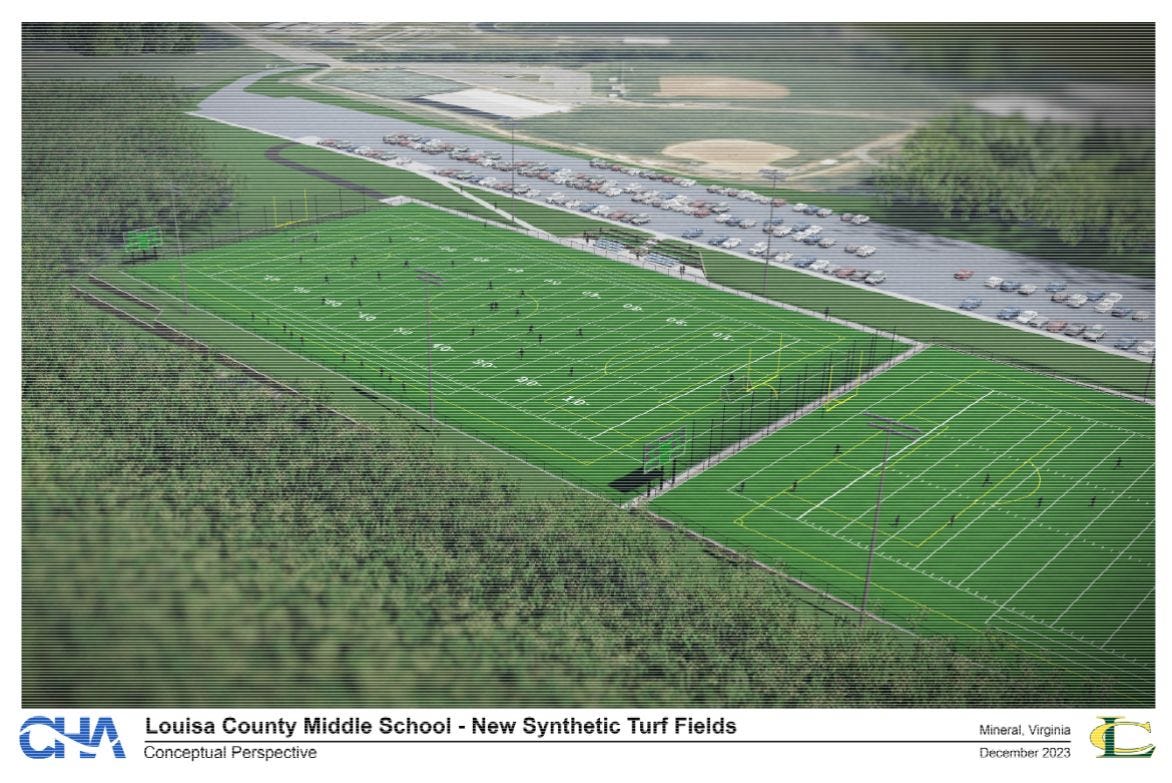Look Back 2024 #5: The Year in the Thomas Jefferson Planning District Commission
The penultimate edition of this necessary look at what happened to prepare for what happens next
The main focus of Charlottesville Community Engagement appears to be Charlottesville followed by Albemarle County, with a healthy dose of stories about land use at the University of Virginia. The hope is to eventually be able to cover surrounding counties in as full a manner as possible. Aspirations are good for any information outlet that seeks to build an audience through explanatory journalism.
Today’s edition focuses on some of the stories I was able to write in 2024 on Fluvanna County, Greene County, Louisa County, and Nelson County. Each has its own identity and each has its own approach to growth and development. They all fit together somehow and none of it can be taken in isolation.
My coverage for these communities is mostly restricted to preview stories in each Week Ahead newsletter. That allows me to have a basic sense of what’s happening, and I read the minutes. People have asked me to cut back, but I write about the region around Charlottesville. This is my home.
Now, let’s get started.
Population
Every January, the Weldon Cooper Center for Public Service releases its population estimates for Virginia and this year’s figures gave a snapshot of how much the region’s components have grown since the U.S. Census.
Overall, the Thomas Jefferson Planning District grew 3.2 percent between the 2020 Census and Weldon Cooper’s July 1, 2023 estimate for a total of 272,011 people. Louisa County added 2,838 new residents during that time period and Albemarle added 3,753 to have a total estimate of 116,148 people. Only Nelson County experienced negative growth.

The Real Estate Market
The real estate market remained sluggish across the region in 2024. In January, the Charlottesville Area Association of Realtors reported that the fourth quarter of 2023 had seen the lowest number of sales in many years, despite increasing costs. The trend of low sales volumes with increasing prices continued in the first quarter of 2024 and into the second quarter and yet again in the third quarter.
Want to make a guess about the fourth? That story will be out in February 2025.
In 2025, one item to watch will be the work the Central Virginia Regional Housing Partnership will undertake to assess the area’s need for shelter.
In 2021, the Thomas Jefferson Planning District Commission adopted a plan called Planning for Affordability that identified potential solutions. (read the document)
The implementation of plans is often only as good as the data that follows. The TJPDC is now in the early stages of conducting another study with more details. The last data was collected in 2019 as part of a housing needs assessment. (view the assessment)
“The median household income at the time was $53,000,” said Laurie Jean Talun, Regional Housing and Community Development Grants Manager for the TJPDC. “There were 485 renter-households and over 1,000 owner-households who were paying more than 30 percent of their income on housing, which we know is cost burdened.”
Nelson County is contributing $10,000 to the study which would be conducted in partnership with the Virginia Center for Housing Research at Virginia Tech. The work will take place over two years and will include community listening sessions.
“They’re really adamant that they want to help localities like ours,” Talun said. “And they’ve worked with lots of different parts of Virginia, covering a lot of the rural areas and understanding the different housing needs of each different rural county.”
While that data is being collected, there’s another study that one could look at to better understand the issue. In November, Piedmont Virginia Community College and the Equity Center at the University of Virginia released the sixth version of something called the Orange Dot Report.
“Our community has seen progress since this work began in 2011, but there are still too many struggling families,” reads the introduction. “For a region as prosperous as ours, we have the means to build programs and enact policy that helps more families become self-sufficient.”
The report covers the same footprint of the Thomas Jefferson Planning District Commission as well as Buckingham County. There are further demographic breakdowns such as an account that 47 percent of Black families and 35 percent of Hispanic families are not able to cover their cost of living, whereas that figure for white families is 18 percent.
Geographically, 27 percent of Charlottesville families are struggling as are 18 percent of Albemarle families.

Economic development
This year, the Thomas Jefferson Planning District Commission adopted something called a Comprehensive Economic Development Strategy.
“The CEDS outlines a strategic vision and actionable goals aimed at fostering economic growth, job creation, and sustainable development within our community,” reads the introduction to the 30-page document.

Water Supply Planning
Another issue that is right outside my grasp is the future of water supply planning in the region. In September, the Rivanna Water and Sewer Authority’s Board of Directors learned that the Commonwealth wants to move to a more regional basis for preparing for tomorrow’s drinking water.
“Albemarle has been grouped with Greene, Louisa, Fluvanna, and Buckingham counties as our new water supply planning area,” said Bill Mawyer.
The new rules introduce an interesting layer of potential governmental interaction at a time when the James River Water Authority has broken ground on a new waterline to serve Zion Crossroads and as Greene County struggles to identify ways to pay for a reservoir permitted by the DEQ. I’m hoping to follow up more in 2025, but Greene considered the idea of making it mandatory for anyone on a sewer line to connect. That would bring in revenue.
During the public comment period for the rule change, Mawyer was the only person to submit something through Virginia’s Regulatory Town Hall.
“We would have concern about water sharing projects becoming mandatory in the future,” wrote Bill Mawyer in the only comment made on Virginia’s Regulatory Town Hall.
Fluvanna County
Fluvanna County adopted a new Comprehensive Plan this year, but only with a few changes in order to satisfy a requirement that a locality update its plan every five years. Almost immediately work began on a new plan intended to find ways to preserve the rural area from development.
Supervisors also approved the removal of a land use provision that allowed for homes to be clustered in rural areas. This was required by state law because Fluvanna had growth exceeding ten percent between the 2000 and 2010 Census, requiring the possibility of having more places for developers to build to meet housing demand.
There is a trend of fewer building permits underway in Fluvanna.
Greene County
There’s a lot happening in Greene County, enough to fill its own newsletter. One of the stories I want to flesh out more is the creation of a new zoning district for emerging technology uses such as data centers and solar panels. In June, Supervisors met with the Planning Commission to explain more about what they wanted to see in such a district.
“They shared a lengthy discussion on each of those topics and their views on ordinance amendments that could protect the rural character of Greene while still allowing these types of businesses in the designated growth areas,” read the minutes of that meeting.
Supervisors also denied a special use permit requested by Beard Mountain Winery for a 26,000 square foot event space. It took some time to get there as a public hearing was delayed. Greene County is now reviewing its rules on agritourism.
One factor to consider for Greene’s future is what role Albemarle County’s Rivanna Futures project will have on population growth.
Louisa County
Louisa County opted to go ahead and spend additional money to build two synthetic turf fields at Louisa Middle School after the project came in over budget.
As I wrote in October, the original cost estimate was for $3,556,830 but the full cost to build two of them is $6,333,268. The resolution for the public hearing explains that the additional $2,777,438 will be taken from long term capital reserves of both general government and the public schools as well as capital funds for parks and recreation.
In July, Governor Glenn Youngkin announced that Dominion Energy Virginia would be building a small modular nuclear facility at the North Anna power station. (read the story)
One day after Dominion Energy filed a new plan in October with Virginia’s State Corporation Commission, the company announced a partnership with Amazon to advance development of small modular reactors at the North Anna power station.
“Power demand in Virginia is growing by more than 5 percent annually and is expected to double in the next 15 years,” reads a press announcement sent out this morning. “To reliably serve this unprecedented growth, Dominion Energy is developing an ‘all-of-the-above’ mix of new power generation sources, including leading investments in offshore wind, solar, battery storage and natural gas.”
Amazon is planning to build two data center campuses in Louisa County and applied for a water permit from the U.S. Army Corps of Engineers in the fall. In November, Supervisors also approved an $88 million public-private partnership to build the infrastructure for the two sites which are located in a technology overlay district.
Another story I did not write was on an application for a Love’s Truck Stop in Louisa County. Supervisors eventually denied the proposal.
Nelson County
Nelson County began work on an update of their zoning code after Supervisors adopted an updated Comprehensive Plan. The county hired the Berkley Group to do both.
“This ordinance impacts the way land is used, developed, and divided,” reads the website set up for the work.
A diagnostic of the existing ordinance has been conducted and many community engagement steps have been taken. According to the website, the new ordinance is about five percent drafted. That’s an incredibly specific number.
Nelson County also sought changes in the ways EMS worked and switched to a schedule where personnel work 24 hour shifts with a three-day break in between.
Another story I would have liked to have covered more relates to energy generation.
Okay. I call time on this one. One more to go and that’s on affordable housing. It’ll be out tomorrow.





